“Although place-words are being lost, they are also being created. Nature is dynamic, and so is language.” –Robert Macfarlane
***
What’s in a name? The Oxford Junior Dictionary has eliminated some words from its children’s dictionary that name things. Acorn. Willow. Buttercup. Kingfisher–and, other words that are about nature. Adults I encounter no longer seem to have a reference point for common names of plants and other members of the natural world.
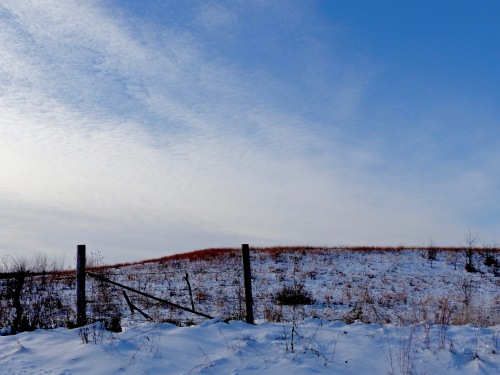
In an adult prairie ethnobotany class I taught this July, I casually mentioned the silky fluff or pappus of milkweed seeds in a pod. Several of my students exchanged blank looks. “You know,” I said, pointing to the milkweed plant in bloom. “The seed pod that comes after the flower.”
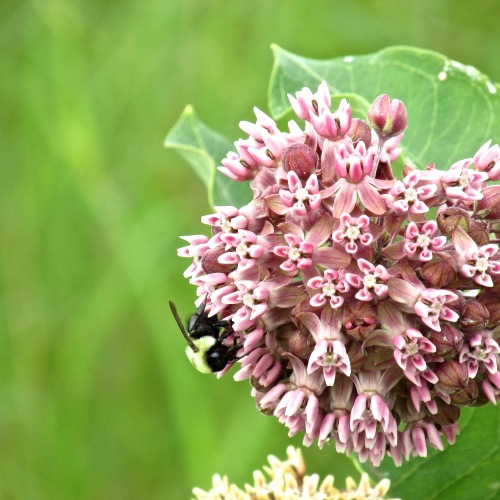
A few people smiled and shook their heads. I asked for a show of hands. “How many of you know what a milkweed pod is?” There were a few nods. But, almost one third of my class did not know what a milkweed pod was. Nor had they cracked one open to sail the canoe-like pod shells on a creek. They hadn’t blown the silky seeds into the wind and watched them float off toward the horizon. The words, “milkweed pod,” and “milkweed seeds” had no meaning for them.

It got me thinking — if words like “kingfisher” are disappearing from our vocabulary in dictionaries and “milkweed pod” no longer conjures up a visual memory or experience for people, how can we return these words to use? Perhaps learning more specific words for the inhabitants of the natural world and sharing them with others in ordinary conversation is one way to keep our landscape full of rich and beautiful names.
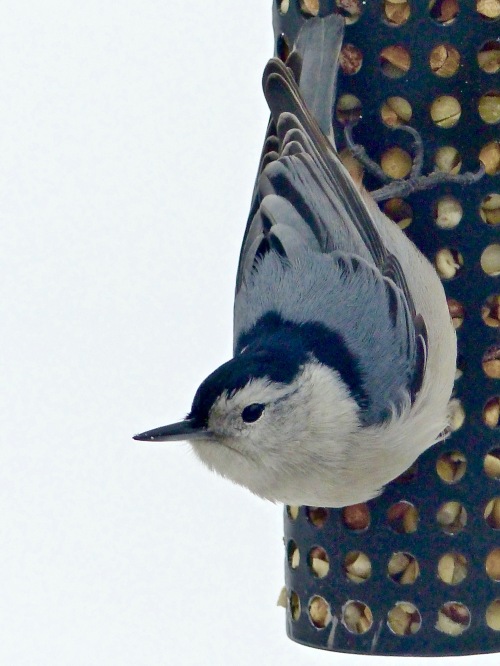
But –are there other words we need to imagine and create for the natural world? Surely there are names we haven’t yet thought of yet. Can we meet this hemorrhage of word loss by contributing our own new words for things on the prairie –descriptions, perhaps, that have not been invented yet? Let’s try a few.
Is there a name for the sandpapered curve of a compass plant leaf in winter, dry and brittle?
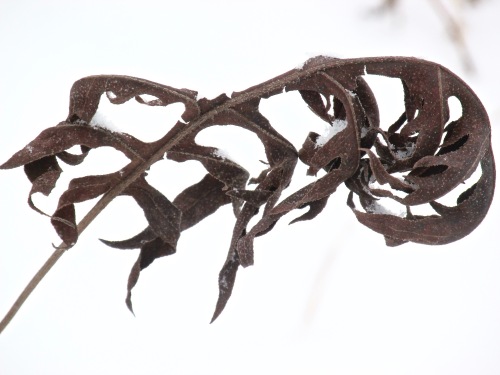
Or a term for the color of pink that flushes the sky in a frigid, December sunrise? 
What might we call the sound of white wild indigo seed pods, rattling in the wind?

Is there a name for the flotsam and jetsam that blows into a coneflower seed head in winter?

Does the voice of a prairie stream, rushing through the ice and snow, beg for a new word to describe it?
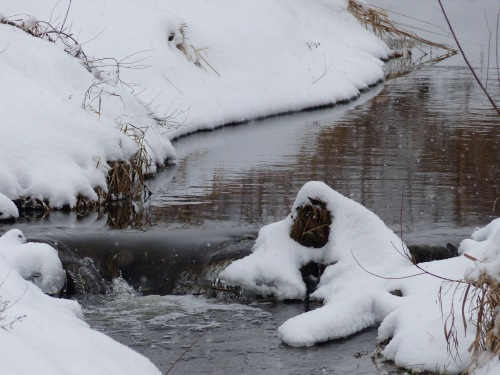
A group of coyotes is called a pack. But is there a name to describe a pair of them, picking their way through the snow and ice, moving toward me? Perhaps better yet — a word to describe how I feel at that moment?

What do you call a clump of snow, caught in the stems of the figwort plant?

“Arch” seems like the wrong word to describe the Canada wild rye seeds against a winter sky. An “apostrophe of rye seed”? An “eyebrow” of wild rye? A “bristle” of rye? Or?

When wild quinine turns silver in the frost, but still emits its clean, fresh scent, what word describes it?

What do you call the sun, when it attempts to break through the wintry sky? And –is there a word for the green of plants persisting under snow? Or for a single tree, punctuating a prairie landscape?
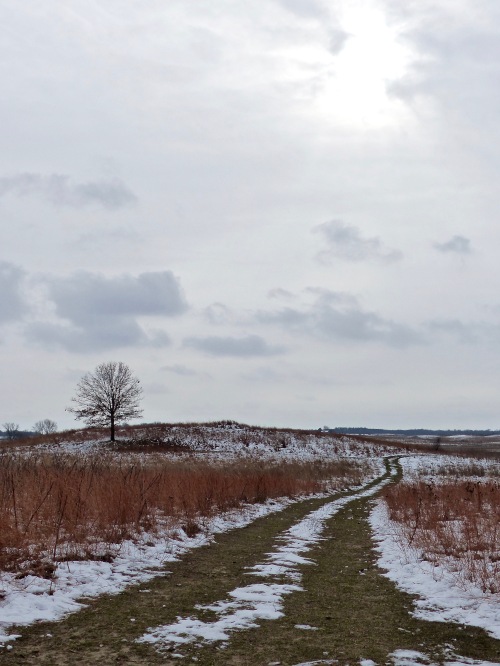
What do you think?
To express the beauty of the prairie–and the natural world– in all its sensory appeal, we may require a new vocabulary. Let’s put one together. I have my words for all of the above. What are yours? Think of compiling this list as a good occupation for a cold winter’s afternoon. Or try this — the next time you hike the prairie, what new word descriptions would you add to the prairie’s dictionary and thesaurus?

Learn some new names for plants, birds, insects, and animals on the prairie. Keep names from becoming lost. Make up your own descriptions for specific things when you can’t find them. Use them. We need these new words –and–we need the existing words we are losing. They help us notice the details. They remind us of the splendor of the natural world. When we use specific words and names, we invite others to appreciate the rich diversity found in tallgrass prairie.
Ready? Let’s get started.
****
British writer Robert Macfarlane’s (1976-) opening quote in this essay is from Landmarks, in which he seeks to re-wild language with specific names for what we discover in the natural world. MacFarlane’s work can be dense, but like all good things, benefits from a second look and a close paying of attention. He believes that if we lose the names for things in the natural world, we may also lose those very places and plants, critters, and landscapes that are named through a gradual lack of interest and care. Worth thinking about.
All photos copyright Cindy Crosby (top to bottom): Nachusa Grasslands in December (Thelma Carpenter Unit), The Nature Conservancy, Franklin Grove, IL; common milkweed (Asclepias syriaca), Nachusa Grasslands, The Nature Conservancy, Franklin Grove, IL; common milkweed pod (Asclepias syriaca); white-breasted nuthatch (Sitta carolinensis), author’s birdfeeders by her prairie patch, Glen Ellyn, IL; compass plant (Silphium lacinatum), Schulenberg Prairie, The Morton Arboretum, Lisle, IL; December sunrise, author’s prairie patch, Glen Ellyn, IL; white wild indigo (Baptisia alba macrophylla) seed pods, Schulenberg Prairie, The Morton Arboretum, Lisle, IL; pale purple coneflower (Echinacea pallida) , Nachusa Grasslands, The Nature Conservancy, Franklin Grove, IL; Willoway Brook, Schulenberg Prairie, The Morton Arboretum, Lisle, IL; two coyotes (Canis latrans), Hidden Lake, Forest Preserve of DuPage County, Downer’s Grove, IL figwort (Scrophularia marilandica) with snow, Schulenberg Prairie, The Morton Arboretum, Lisle, IL; Canada wild rye (Elymus canadensis), Nachusa Grasslands, The Nature Conservancy, Franklin Grove, IL; wild quinine (Parthenium integrifolium), Nachusa Grasslands, The Nature Conservancy, Franklin Grove, IL; December at Nachusa Grasslands, The Nature Conservancy, Franklin Grove, IL; Thelma Carpenter Unit, Nachusa Grasslands, The Nature Conservancy, Franklin Grove, IL.

Hi Cindy-
I LOVED this today. Will spend some time making up names this morning.
Merry Christmas to you and Jeff!
Barb
Sent from my iPad
>
LikeLiked by 1 person
I would love to hear about some of your name choices! You are such a talented writer. Merry Christmas to you and Mike!
LikeLike
That’s a very cool idea. Thank you, Cindy. Best wishes for Christmas and the New Year.
LikeLiked by 1 person
Merry Christmas to you! Keep posting prairie photos — I love to see them, Susan.
LikeLike
This is what poetry is for. 🙂
LikeLiked by 1 person
I agree, Erin — thank you for that comment, and thank you for reading!
LikeLike
I really enjoy this post, Cindy. Learned a few things I didn’t know before.
LikeLiked by 1 person
Thank you, Tim! I appreciate you.
LikeLike
Prairie plantings at Nachusa Grasslands sometimes exhibit partially exposed rocks with the bulk underground like an icebergs. We call them “runkers”.
LikeLiked by 1 person
I think “runkers” is going to be one of my new favorite Nachusa words! Thank you, Bernie, for sharing!
LikeLike
Crazy how this colloquial challenge has me waxing poetic, out in the fields so to speak. Dried contorted compass plant leaf I’ve always associated with a “crows foot”. And the winter sunrise pink as “promise pink”. The coneflower flotsam as “windlint”. Perhaps the snow clumps are “cling ons”. It’s also interesting the vo-ICE of a stream sound in winter!
LikeLike
Those are amazing words, Mike! I think “windlint” is going to be one of my new prairie vocab words. The others are so descriptive as well…. I didn’t even think of the voICE!!! Thanks for sharing.
LikeLike
Once again, your photos have shown the beauty of Winter ……they make me want to grab my camera and walk our fields! And thank you for bringing attention to the potential loss of words as well as the potential for creating new ones. I’d like to walk your prairie with you and your eyes the next time Alan and I are in Chicago. Let’s get started!
LikeLiked by 1 person
Thank you, Cathie — come and hike! I hope you do grab your camera and walk the fields…. you’ll have to come visit the prairies here when you can! 🙂
LikeLike
Hmmm…such food for thought.
It is appalling that words I take for granted and words that describe delight and bring fond memories mean nothing to so many. A lost language, a lost way to communicate. Thank you for this food for thought and for a year of incredible Tuesdays in the Tallgrass. You ‘ministry’ is wonderful in so any ways.
Blessings to you and yours in this sacred season and into our new year! hugs! Mary Alice
>
LikeLiked by 1 person
Hugs to you as well, Mary Alice! Thank you for your ongoing readership and especially, encouragement as a fellow traveler in the natural world. I appreciate you and the thoughtful comments you have. Happy New Year!
LikeLike
What a great idea. Just discovered your lovely blog via a friend who posted it on Facebook. I’m a long-time member of the Morton Arboretum and walk the prairie every chance I get. Never fail to discover something wonderful.
I love that word “windlint,” by the way.
LikeLiked by 1 person
Hi Mary –I’m so glad you read the blog and enjoyed it! Thank you for commenting. It’s nice to “meet” a fellow Schulenberg Prairie fan! I loved “windlint” as well — I think it needs to be in the prairie dictionary! See you on the prairie…..
LikeLike
I loved your elevation of the simple beauty intrinsic to all the component parts of the prairie ecosystem. A minor Erratum–The photo labeled as Pycnanthemum virginianum is instead Parthenium integrifolium. See the involucral bracts of Parthenium vs. the little capsule-like calyces held in clusters in Pycnanthemum.
LikeLiked by 1 person
Awesome catch! I made the change. Thank you for your correction, and thank you for reading!
LikeLike
Indigenous peoples have many words for things like “snow” and such, which described not only the state of the snow, but what it looked like, where it was located and how it was formed. They have a very rich and beautiful language. We could learn from this and do the same!
LikeLiked by 1 person
So true– thank you for that reminder! And thank you for reading.
LikeLike
Children have an amazing talent for describing things in their simplest most purest form …when seen through their innocent eyes. A natural world vocabulary project would be a wonderful endeavor for an elementary class or 4-H chapter. Comprising “A Child’s View of Nature” dictionary, could be an insightful and educational adventure for both the young and the old(er).
LikeLiked by 1 person
Agreed! A wonderful project to do, with family, friends, schools, or natural areas visitors. Thanks for reading!
LikeLike
My wife discovered this post via Pollinator PowWow, through her Facebook feed. We both really enjoyed it, so I’ve added a link to it on our website.
http://www.thesnkwildlifereserve.com
We are currently working on a grassland restoration project in our front 40 acres.
We’ll be looking into your site in more depth, for sure!
Keith, the K at The SnK
LikeLiked by 1 person
Thank you for reading! I will check out your website– thank you for sharing. Good luck with your restoration! It’s so wonderful to connect with kindred prairie spirits.– Cindy
LikeLike
This was beautiful. I’ve thought about this too, but not this eloquently. As a parent, a restoration volunteer, and a Scout leader, I run into kids who don’t know what a cattail is, let alone its value in thwacking against another kid; that they should avoid stingweed; how bedstraw is nature’s sticky-note; that the full moon is mostly seen at night and the new moon during the day; even that in the morning the sun is in the east.
I’ve at least tried to pass that on to my son. How much of it he retains, I don’t know, but at least he’s been exposed to it.
LikeLiked by 1 person
Thank you for reading and commenting, Rob. It’s folks like you who offer that vocabulary of the natural world to others which gives me hope for our future! Keep up the good work — one child and one person at a time.
LikeLike
Pingback: Outdoor Classroom News Early Spring 2017 – Minnesota Master Naturalist
Thank you for reading and commenting! Love the Master Naturalist program — I teach prairie in the Illinois program. I appreciate you keeping the vocabulary of the natural world alive!
LikeLike
Pingback: Minnesota Master Naturalist